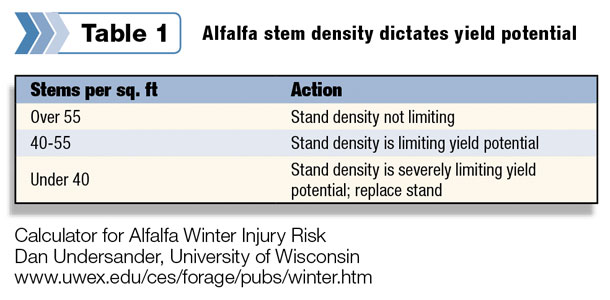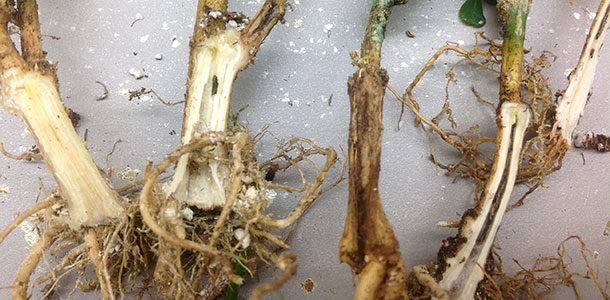Polar vortex is not alfalfa friendly
Winter injury of alfalfa is the result of many factors. This winter’s series of polar vortex cold snaps may result in cold injury to crowns where snow cover is inadequate. Alfalfa crowns can be damaged when the temperature in the top 2-4 inches of soil reaches 5-15°F. Melting snow and rain events lead to ice sheeting in fields. This can damage alfalfa by starving the plants of oxygen. Fields with tall stubble often help in these situations. Finally, freeze-and-thaw cycles in the spring can result in severed taproots and lateral roots as crowns are pushed above the root surface. This results in poor regrowth and yield potential along with the possibility of crown desiccation and death.
Alfalfa varieties have differing levels of winterhardiness, which can be gauged using a standardized test. Consult university studies and company literature for the level of alfalfa winterhardiness best suited for your geography. In recent years, winterhardiness traits have been bred to be partially disassociated from fall dormancy (FD) traits. This means you can plant an FD 5 variety with very high levels of winterhardiness.
Top considerations for evaluating alfalfa stands
- Watch stands with slow regrowth. Slow regrowth, along with asymmetrical growth of stems from the crown, are often signs of injury.
- Know your alfalfa stem density. Get down on your hands and knees and count stems in a square foot. See the Chart below for determining yield potential at various densities.
- Dig deep to see how alfalfa roots and crowns are faring. White, firm roots are good; brown, yellowish-brown, soft roots are bad. See the image above as an example.
- Evaluate the distribution of damage. Alfalfa fields are rarely uniformly damaged, so walk the field to assess what percent of the field is not going to contribute to yield.
- Get another opinion. There is a lot riding on your decision to keep or rotate your stands. Use another set of experienced eyes.
- Look at all of the predisposing factors, including previous stress from disease, drought or traffic, along with stand age and grass percentage in the stand.
- Consider your forage inventory and land base. By keeping a marginal alfalfa stand, you may jeopardize your homegrown feed inventory. Switching to corn silage may be a better way to fill a silo.
 Dos and don’ts
Dos and don’tsYes, there are some dos and don’ts when making springtime decisions for your alfalfa crop.
The good stand
Do manage for top performance when good to excellent stands exist. This means P and K top-dress fertilizer applications, weed control and insect control and consider a foliar fungicide if conditions warrant it. Do cut at normal intervals for optimizing forage quality and yield.
The bad stand
Do not expect miracle recoveries. Once alfalfa is visibly injured and regrowth is slow, yield potential is reduced. Do delay first cut to help plants recover as much as possible. Do fertilize with N if you have a grass species in your alfalfa; this encourages grass growth which compensates for missing alfalfa.
The ugly stand
Do rotate marginal stands to another more productive forage species. Do not try to reseed alfalfa into the same field due to the autotoxic effects of alfalfa for at least one year.
When plowing down, alfalfa pays a dividend
Plowing down alfalfa stands often comes after a difficult evaluation period that involves hope and disappointment as your stands begin to regrow from a long winter rest. Making the call to plow down alfalfa results in a disruption of your crop rotation and forage inventory. However, there is at least one benefit to your cropping system – nitrogen.
Most Midwest universities recommend reducing or eliminating N-fertilizer applications for first-year corn after alfalfa thanks to the nitrogen reserve alfalfa leaves in the soil. In addition to the N benefit, there is a rotational benefit for corn following alfalfa as compared to corn following corn. FG
Dan Wiersma
Livestock Information Manager
DuPont Pioneer











